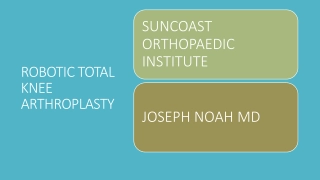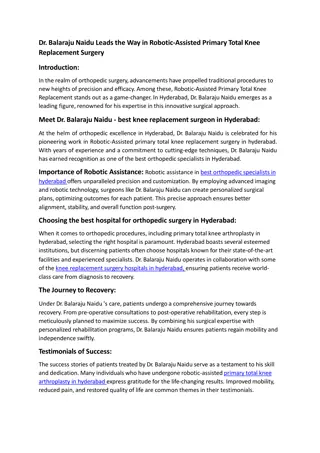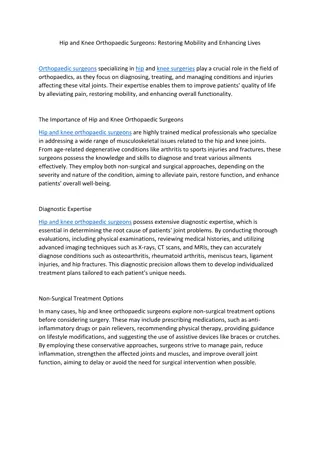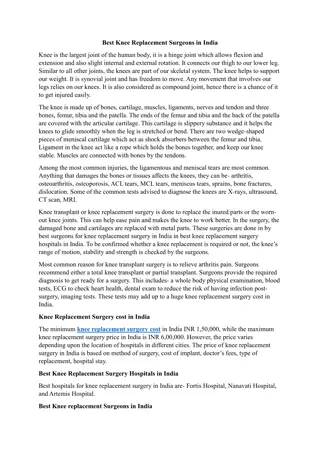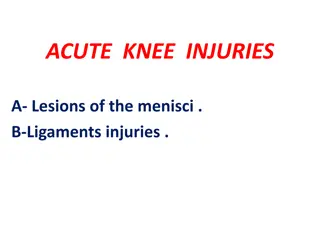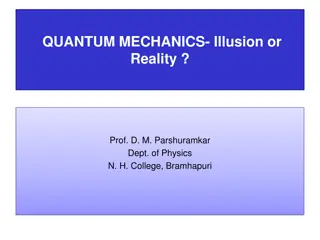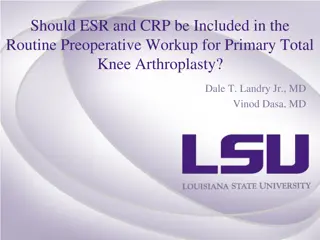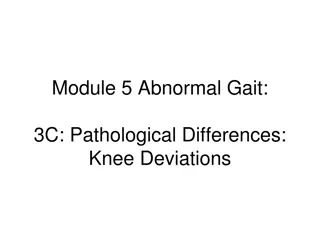The Mechanics of the Knee
Forces and mechanical models involved in lower leg exercises for quadriceps muscle strengthening are analyzed, resulting in the determination of relevant magnitudes. The solution to calculate compressive forces on the tibial plateau at the knee joint is provided.
Download Presentation

Please find below an Image/Link to download the presentation.
The content on the website is provided AS IS for your information and personal use only. It may not be sold, licensed, or shared on other websites without obtaining consent from the author.If you encounter any issues during the download, it is possible that the publisher has removed the file from their server.
You are allowed to download the files provided on this website for personal or commercial use, subject to the condition that they are used lawfully. All files are the property of their respective owners.
The content on the website is provided AS IS for your information and personal use only. It may not be sold, licensed, or shared on other websites without obtaining consent from the author.
E N D
Presentation Transcript
The Mechanics of the Knee EXAMPLE 3 Milan S. Kova evi Milan S. Kova evi Faculty of Science, Department of Physics University of Kragujevac Serbia e-mails: kovac@kg.ac.rs milan.kovacevic@pmf.kg.ac.rs Fo a, BiH, Fo a, BiH, 202 2022. 2.
Forces acting on the lower angle Consider a person wearing a weight boot, and from a sitting position, doing lower leg flexion/extension exercises to strengthen the quadriceps muscles (Fig. 5.37). Forces acting on the lower leg and a simple mechanical model of the leg are illustrated in Fig. 5.38. Fo a, BiH, Fo a, BiH, 202 2022. 2.
Mechanical model - description W1 is the weight of the lower leg, W0 is the weight of the boot, FM is the magnitude of the tensile force exerted by the quadriceps muscle on the tibia through the patellar tendon, and FJ is the magnitude of the tibiofemoral joint reaction force applied by the femur on the tibial plateau. The tibiofemoral joint center is located at point O, the patellar tendon is attached to the tibia at point A, the center of gravity of the lower leg is located at point B, and the center of gravity of the weight boot is located at point C. The distances between point O and points A, B, and C are measured as a, b, and c, respectively. For the position of the lower leg shown, the long axis of the tibia makes an angle with the horizontal, and the line of action of the quadriceps muscle force makes an angle with the long axis of the tibia. Fo a, BiH, Fo a, BiH, 202 2022. 2.
The task Assuming that points O, A, B, and C all lie along a straight line, determine FM and FJ in terms of a; b; c; ; ; W1, and W0. Fo a, BiH, Fo a, BiH, 202 2022. 2.
The solution Fo a, BiH, Fo a, BiH, 202 2022. 2.
The Solution Fo a, BiH, Fo a, BiH, 202 2022. 2.
The Solution The magnitude of the resultant compressive force applied on the tibial plateau at the knee joint The magnitude of the resultant compressive force applied on the tibial plateau at the knee joint is Fo a, BiH, Fo a, BiH, 202 2022. 2.
Remarks The force FM exerted by the quadriceps muscle on the tibia through the patellar tendon can be expressed in terms of two components normal and tangential to the long axis of the tibia (Fig. 5.40). The primary function of the normal component FMn of the muscle force is to rotate the tibia about the knee joint, while its tangential component FMt tends to translate the lower leg in a direction collinear with the long axis of the tibia and applies a compressive force on the articulating surfaces of the tibiofemoral joint. Since the normal component of FM is a sine function of angle , a larger angle between the patellar tendon and the long axis of the tibia indicates a larger rotational effect of the muscle exertion. This implies that for large , less muscle force is wasted to compress the knee joint, and a larger portion of the muscle tension is utilized to rotate the lower leg about the knee joint. Fo a, BiH, Fo a, BiH, 202 2022. 2.
Remarks One of the most important biomechanical functions of the patella is to provide anterior displacement of the quadriceps and patellar tendons, thus lengthening the lever arm of the knee extensor muscle forces with respect to the center of rotation of the knee by increasing angle (Fig. 5.41a). Surgical removal of the patella brings the patellar tendon closer to the center of rotation of the knee joint (Fig. 5.41b), which causes the length of the lever arm of the muscle force to decrease d2<d1. Losing the advantage of having a relatively long lever arm, the quadriceps muscle has to exert more force than normal to rotate the lower leg about the knee joint
Thank you for your atention Thank you for your atention! ! Dr Milan Kova evi , Full Professor Faculty of Science, Department of Physics University of Kragujevac kovac@kg.ac.rs milan.kovacevic@pmf.kg.ac.rs Fo a, BiH, Fo a, BiH, 202 2022. 2.


